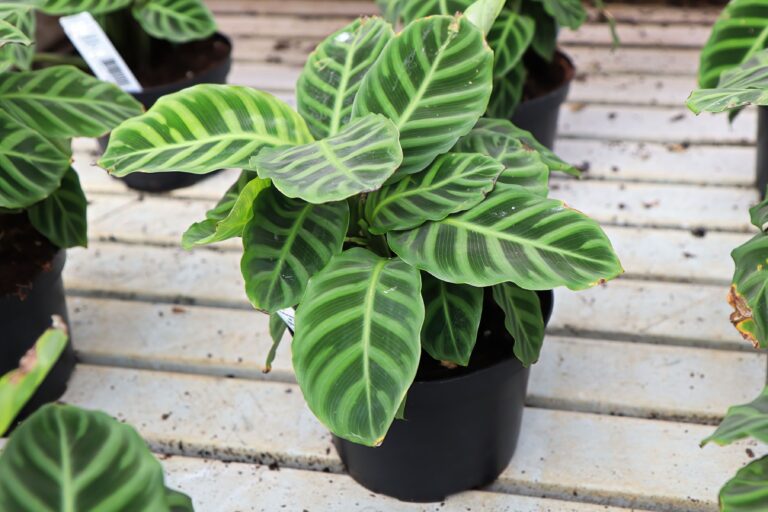Are you looking to add some greenery to your home but need help figuring out where to start? Look no further than the Calathea Zebrina – a stunning plant with striped leaves that will bring life and color to any room. But before you rush out to buy one, knowing how to care for it is important. This article unlocks the secrets to growing and taking care of Calathea Zebrina in your home. From light and water requirements to the best soil and fertilizers, we’ll cover everything you need to know to keep your plant thriving.
You’ll learn how to avoid common mistakes and troubleshoot any issues that may arise. With our expert tips, you can showcase your beautiful Calathea Zebrina and impress all your friends with your green thumb. So, let’s get started!
Understanding the Plant’s Environment and Needs
To succeed in Calathea Zebrina Care, you need to know everything that makes it tick. The Calathea Zebrina is native to the rainforests of Brazil, which means it thrives in a warm and humid environment. If you live in a dry or cold climate, you may need to take extra steps to ensure your plant stays healthy. One of the most important factors in the health of your Calathea Zebrina is the amount of light it receives. Too much direct sunlight can scorch the leaves, while too little light can cause the plant to become leggy and weak.
To find the perfect balance, place your plant in a bright, indirect light. A north or east-facing window is ideal, as it will provide enough light without exposing the plant to direct sunlight. If your home doesn’t have a suitable window, you can use grow lights to mimic natural daylight.
Another important factor in the health of your Calathea Zebrina is the humidity level. These plants thrive in a humid environment, so providing them with enough moisture is important. You can do this by misting the leaves with water, placing a humidifier nearby, or placing the plant on a tray of pebbles filled with water. This will help to keep the air around the plant moist and prevent the leaves from drying out.
Ideal Soil and Pot for Calathea Zebrina Care Success
Choosing suitable soil and pot is essential for the health of your Calathea Zebrina. These plants prefer well-draining soil that is rich in organic matter. A mixture of peat moss, perlite, and vermiculite is a good choice, as it will provide the plant with the nutrients it needs while allowing excess water to drain away.
When choosing a pot, ensure it has drainage holes at the bottom. This will allow excess water to drain away and prevent the roots from waterlogging. Choose a pot that is slightly larger than the current size of your plant, as Calathea Zebrinas prefer to be slightly pot-bound. This will also help to prevent overwatering, as the soil will dry out more quickly in a smaller pot.
Light and Temperature Requirements
Calathea Zebrina thrives in bright, indirect light. Avoid placing it in direct sunlight, as it can scorch the leaves. Ideally, position your plant near a north or east-facing window where it can receive filtered sunlight throughout the day. If natural light is limited in your space, you can also use fluorescent grow lights to provide adequate illumination.
In terms of temperature, Calathea Zebrina prefers warm and consistent conditions. Keep the temperature around 65-80°F (18-27°C) during the day and avoid exposing the plant to temperatures below 60°F (15°C).
Watering and Feeding Your Calathea Zebrina
Watering your Calathea Zebrina can be a delicate balance. These plants prefer to be kept consistently moist but not waterlogged. Overwatering can lead to root rot and other issues, while underwatering can cause the leaves to wilt and dry out.
To water your Calathea Zebrina, wait until the top inch of the soil feels dry to the touch. Then, water the plant thoroughly, making sure the water drains away from the pot. Don’t let the plant sit in standing water, which can lead to root rot.
Feeding your Calathea Zebrina is also important for its health and vibrancy. These plants prefer to be fed with a balanced, water-soluble fertilizer every two weeks during the growing season (spring and summer). You can use a half-strength fertilizer to avoid overfeeding and burning the roots.
Leaf Care and Maintenance
Calathea Zebrina’s leaves are its main attraction, and proper care ensures they remain vibrant and healthy. Wipe the leaves gently with a soft, damp cloth to remove dust and allow them to breathe. Avoid using commercial leaf shine products as they can clog the pores and hinder the plant’s transpiration process.
Pruning and Grooming
Regular pruning helps maintain the plant’s shape and appearance. Remove any yellowed or damaged leaves using clean, sharp scissors or pruning shears. Trimming can also be done to control the plant’s height and promote bushier growth. Make sure to disinfect your tools before and after pruning to prevent the spread of diseases.
Pest Control
While Calathea Zebrina is generally resistant to pests, it can occasionally face infestations.To succeed in Calathea Zebrina care, you must keep away common houseplant pests such as spider mites, aphids, and mealybugs. Act promptly if you notice any signs of pest activity, such as webbing, sticky residue, or tiny insects.
Begin by isolating the affected plant to prevent the pests from spreading. Use a gentle insecticidal soap or neem oil spray to treat the pests, following the instructions on the product label. Repeat the treatment as necessary until the infestation is eradicated.
Common Issues and Troubleshooting
Calathea Zebrina may encounter a few common issues affecting its overall health. Here are some troubleshooting tips to address these problems:
- Leaf Curling: If the leaves are curling, it usually indicates low humidity or underwatering. Increase humidity levels and adjust your watering routine to keep the soil consistently moist.
- Leaf Browning: Brown leaf tips or edges can indicate low humidity, overwatering, or water with high salt content. Increase humidity, adjust your watering practices, and consider using distilled or filtered water to avoid mineral build-up.
- Yellowing Leaves: Yellowing leaves can be caused by overwatering, underwatering, or exposure to direct sunlight. Evaluate your watering habits and adjust accordingly. Move the plant to a location with filtered light if necessary.
- Drooping Leaves: Drooping leaves may indicate underwatering or excessive light exposure. Ensure the soil is moist, and consider adjusting the plant’s placement to a spot with less direct sunlight.
Remember that Calathea Zebrina is sensitive to environmental changes, so it’s normal for the plant to experience minor leaf adjustments as it acclimates to its new surroundings.
Propagating Calathea Zebrina
Propagating Calathea Zebrina allows you to expand your plant collection or share this beauty with fellow plant enthusiasts. Here are two standard methods of propagation you can try:
Division Method
- Choose a healthy, mature plant that has multiple stems or shoots.
- Carefully remove the plant from its pot and gently separate the root clumps into smaller sections, ensuring each section has roots and at least one stem.
- Plant each divided section into its pot with fresh, well-draining soil.
- Provide the newly divided plants with the same care as established Calathea Zebrina, ensuring adequate moisture, light, and humidity.
Propagation Through Stem Cuttings
- Select a healthy stem from the parent plant with at least two leaves.
- Using a clean, sharp knife or scissors, cut the stem just below a leaf node (the point where a leaf is attached to the stem).
- Dip the cut end of the stem in a rooting hormone powder to encourage root development (optional).
- Plant the cutting in a small pot with moistened, well-draining soil or a propagation medium like perlite or vermiculite.
- Cover the pot with a plastic bag or place it in a propagator to create a humid environment.
- Keep the soil moist and provide indirect light to the cutting. Rooting should occur within a few weeks.
- Once the cutting has established roots and shows signs of new growth, it can be transferred to a larger pot with regular Calathea Zebrina care.
Enjoying Calathea Zebrina
Calathea Zebrina adds a touch of tropical elegance to any indoor space. Here are some tips to help you enjoy its beauty to the fullest:
Display and Placement Ideas
Calathea Zebrina looks stunning when placed on a stand or pedestal, allowing its tall, striped leaves to take center stage. Consider placing it in areas where its beauty can be appreciated, such as living rooms, hallways, or corners in need of a vibrant focal point.
Decorative Companions
Pair your Calathea Zebrina with other plants that thrive in similar conditions to create a lush and harmonious display. Consider plants like Maranta, Calathea Orbifolia, or Philodendron Brasil. The contrasting foliage and textures will add depth and visual interest to your indoor jungle.
Seasonal Care and Considerations
During the warmer months, you can bring your Calathea Zebrina outdoors to enjoy the fresh air and filtered sunlight. However, ensure it is placed in a shaded spot to protect it from direct sunlight, strong winds, and temperature fluctuations. Monitor the plant closely for any signs of stress and bring it back indoors if necessary.
Remember to rotate your Calathea Zebrina periodically to ensure even growth and prevent it from leaning towards a light source.
Conclusion
Growing a vibrant Calathea Zebrina in your home is a great way to add some greenery and life to your space. You can keep your plant healthy and thriving by understanding the plant’s environment and needs, choosing the right soil and pot, and providing it with enough water and nutrients. With our expert tips and troubleshooting advice, you’ll be able to showcase your beautiful Calathea Zebrina and impress all your friends with your green thumb.
FAQs
How often should I water my Calathea Zebrina?
Calathea Zebrina prefers consistently moist soil. Water it when the top inch of the soil feels dry to the touch, but avoid overwatering to prevent root rot.
Can I place my Calathea Zebrina in direct sunlight?
It’s best to avoid placing your Calathea Zebrina in direct sunlight as it can scorch the leaves. Opt for bright, indirect light instead.
Why are the leaves of my Calathea Zebrina turning brown?
Brown leaf tips or edges often indicate low humidity, overwatering, or water with high salt content. Adjust the humidity, watering routine, and water quality to address this issue.
How often should I fertilize my Calathea Zebrina?
During the growing season, fertilize your Calathea Zebrina every two to four weeks with a balanced, water-soluble houseplant fertilizer. Reduce the frequency to once every six to eight weeks during the dormant period.
Can I propagate Calathea Zebrina in water?
While some plants can be reproduced in water, Calathea Zebrina is best propagated through division or stem cuttings using a well-draining soil or propagation medium.
Should I mist my Calathea Zebrina?
Misting can help increase humidity levels around your Calathea Zebrina, which it appreciates. However, it’s not the sole source of moisture, so ensure to water the soil adequately.
Can Calathea Zebrina survive in low light conditions?
Calathea Zebrina can tolerate low light conditions but still requires some indirect light to thrive. Place it near a north or east-facing window, or use grow lights to provide adequate illumination.




